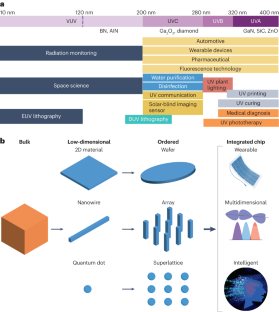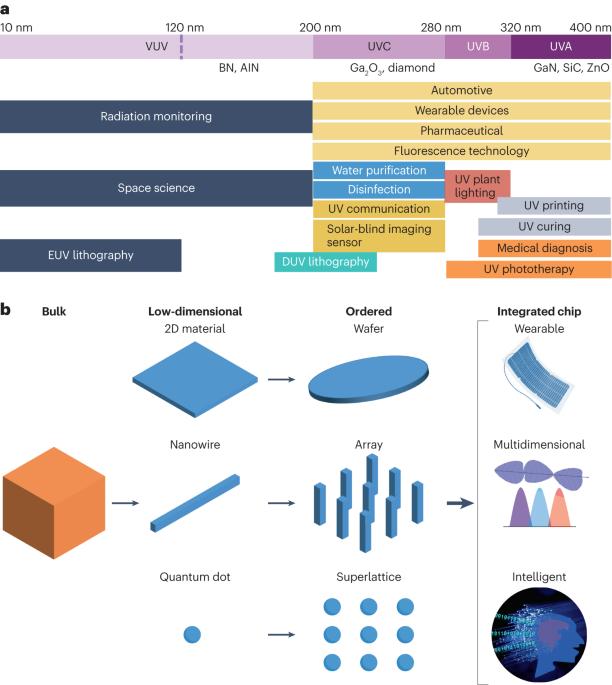用于紫外光电探测器的低维宽禁带半导体
IF 79.8
1区 材料科学
Q1 MATERIALS SCIENCE, MULTIDISCIPLINARY
引用次数: 14
摘要
精确的紫外光检测是现代光电技术的重要组成部分。目前的紫外光检测器主要基于宽带隙半导体(WBS),如 III-V 族半导体。然而,传统的 WBS 已经达到了集成度低和不灵活的瓶颈。因此,具有合适的紫外吸收、可调性能和良好兼容性的低维 WBS 对于多样化的紫外应用具有吸引力。基于低维 WBS 的紫外光检测器在成像、通信、多光谱和/或弱光检测以及柔性和可穿戴电子产品方面具有广阔的应用前景。本综述重点介绍基于低维 WBS 的紫外光检测器领域的进展、挑战和前景。我们探讨了 WBS 的材料设计、尺寸工程和器件工程如何控制其形态结构和性能,并试图阐明材料生长、器件结构和应用场景之间的相互作用。基于低维宽带隙半导体的紫外光检测器可在成像、通信、多光谱和/或弱光检测以及柔性电子器件等应用场景中提供可穿戴、多维和智能功能。本综述重点关注宽带隙半导体在紫外光领域的材料设计、尺寸工程和器件工程。本文章由计算机程序翻译,如有差异,请以英文原文为准。


Low-dimensional wide-bandgap semiconductors for UV photodetectors
Accurate UV light detection is a crucial component in modern optoelectronic technologies. Current UV photodetectors are mainly based on wide-bandgap semiconductors (WBSs), such as III–V semiconductors. However, conventional WBSs have reached a bottleneck of low integration and inflexibility. In this regard, low-dimensional WBSs, which have suitable UV absorption, tunable performance and good compatibility, are appealing for diversified UV applications. UV photodetectors based on low-dimensional WBSs have broad application prospects in imaging, communication, multispectral and/or weak light detection and flexible and wearable electronics. This Review focuses on the progress, open challenges and outlook in the field of UV photodetectors on the basis of low-dimensional WBSs. We examine how material design, dimensionality engineering and device engineering of WBSs can control their morphological structures and properties and attempt to clarify the interplay among material growth, device structure and application scenarios. UV photodetectors based on low-dimensional wide-bandgap semiconductors offer wearable, multidimensional and intelligent functions in the scenarios of imaging, communication, multispectral and/or weak light detection and flexible electronics. This Review focuses on the material design, dimensionality engineering and device engineering of wide-bandgap semiconductors in diversified UV applications.
求助全文
通过发布文献求助,成功后即可免费获取论文全文。
去求助
来源期刊

Nature Reviews Materials
Materials Science-Biomaterials
CiteScore
119.40
自引率
0.40%
发文量
107
期刊介绍:
Nature Reviews Materials is an online-only journal that is published weekly. It covers a wide range of scientific disciplines within materials science. The journal includes Reviews, Perspectives, and Comments.
Nature Reviews Materials focuses on various aspects of materials science, including the making, measuring, modelling, and manufacturing of materials. It examines the entire process of materials science, from laboratory discovery to the development of functional devices.
 求助内容:
求助内容: 应助结果提醒方式:
应助结果提醒方式:


